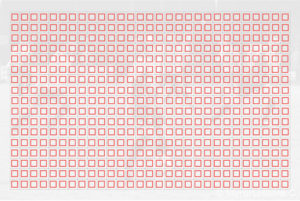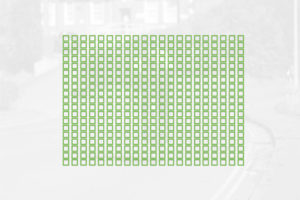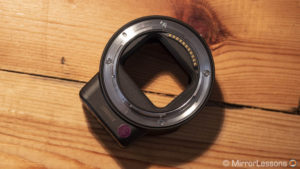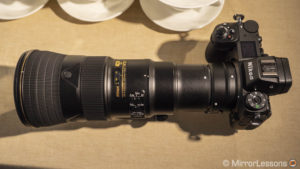Note: the product images show the A7 III instead of the A7R III, but the two Sony cameras have the same design.
Update: our Z7 vs A7R III full comparison is now online!
The A7R II and its successor the A7R III have long been praised for their image quality thanks to their excellent full frame sensors. Nikon wasn’t far behind with the D850 and has now released a “mirrorless version” with a similar resolution. The fact that the flagships Z7 and A7R III have become direct competitors shouldn’t come as a surprise to anyone!
On one hand, we have a brand new product complete with an ergonomic design and interesting features will appeal to both current mirrorless and Nikon DSLR users. On the other, we have the third generation of a camera that has matured and improved over the years, all the while maintaining the lead in the image quality department. Let’s see how they stack up against each other in this comparison preview!
Nikon Z7 comparison previews:
Nikon Z7 full comparison:
What they have in common:
- high resolution EVF with 3.6M dots
- 4K video recording up to 30fps with pixel binning in full frame mode, full pixel readout in APS-C mode
- 120fps in 1080p with in-camera slow motion capabilities
- Mic input, headphone output, USB C port, HDMI (Mini Type on the Z7, Micro Type D on the A7R III)
- Wifi and Bluetooth
Ethics statement: the following is based on our experience with the Nikon Z7 at the launch event and our long-term experience with the A7R III that we currently own. Click here to read the full comparison. We were not asked to write anything about these products, nor were we provided with any compensation of any kind. All opinions we express regarding these products are our own. Within the article, there are affiliate links. If you buy something after clicking one of these links, we will receive a small commission. To know more about our ethics, you can visit our full disclosure page. Thank you!
1. Sensor
The Z7 and A7R III share the same 35mm/full frame format and use a sensor with backside illumination (BSI) and no AA filter. The resolution is slightly different: the Z7 has 45.7MP while the A7R III has 42.4MP.
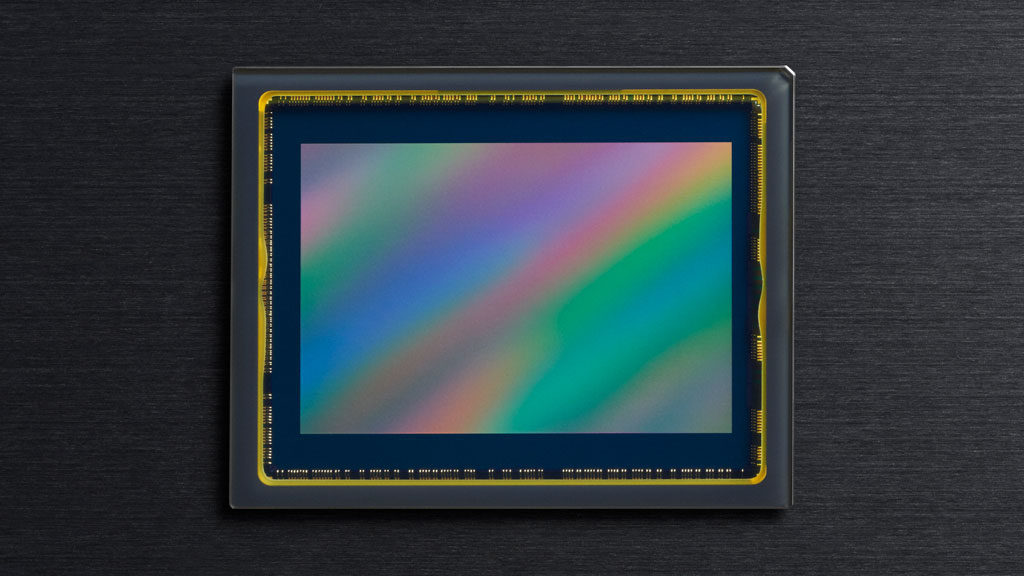
The Z7 starts from a native ISO of 64 whereas the Sony starts from a base of 100 ISO. The Nikon goes up to 25600, or 102400 with the extended values, and also has a low value of ISO 32. The A7R III maxes out at 32000 ISO and shares the same highest extended sensitivity as the Z camera, but the lowest value is ISO 50.
2. RAW compression
Like all high-end Nikon DSLRs, the Z7 gives you lots of choice when it comes to image files. You can record in NEF (Nikon’s RAW file) in 12-bit or 14-bit, as well as choose three levels of compression (uncompressed, lossless or compressed). You can record in Tiff in addition to JPG.
The A7R III gives you a choice of compressed or uncompressed for the RAW file and doesn’t offer a Tiff option.
Note than when shooting in continuous extended mode (the fastest) on the Z7, only 12-bit RAW is available. On the A7R III, the bit depth drops to 12-bit when shooting in continuous mode with the compressed RAW option, when using long exposure noise reduction and in Bulb mode.
3. Autofocus
The Z7 features on-sensor phase detection with 493 points that cover approximately 90% of the sensor. It has more points than the A7R III which features 399 phase detection areas across 68% of the sensor’s surface.
The Z7 also has more sensitivity with -4Ev (f2) when the Low Light AF mode is activated. The Sony is one stop less sensitive at -3Ev at the same aperture.
Both cameras include a Face detection mode but only the Sony has the excellent Eye AF. At the press event, face detection on the Z7 didn’t impress me but my opinion has changed after testing the camera for several weeks. (check the full comparison to find out more)
Concerning the autofocus performance in general, I found the Z7 very good concerning locking speed and reactivity. The A7R III does an excellent job with the autofocus as explained in our A7 III vs A7R III comparison, and proved reliable in different conditions and for various subjects.
Both cameras offer the possibility to use DSLR lenses with a compatible adapter and retain autofocus capabilities. There are many options available for Sony: its own LA-EA3 for A-mount lenses, as well as several offerings from Sigma, Metabones and others to adapt Canon EF lenses or even Nikkor lenses. The performance is not as good as with native E-mount lenses and it can vary from one specific lens to another, but it’s definitely good enough for many situations.
Nikon has developed its own FTZ adapter to be used with its range of Nikkor lenses. It offers full compatibility with autofocus on 93 lenses (AF-S and AF-I that have an internal AF motor ) and partial compatibility with more than 300 lenses. I briefly tested it with the 24-70mm f2.8 and the new 500mm f5.6 and I was pleased to see that they had a similar level of reactivity as the native Z lenses.
4. Burst speed
The Z7 can shoot at a maximum of 9fps but the camera prioritise speed over AF/AE tracking. The A7R III is ever so slightly faster with a maximum of 10fps with full AF/AE tracking.
At their respective maximum burst speeds, the last image taken is shown in rapid succession on the screen of the EVF or LCD screen. You can have live view with blackouts if you lower the speed to 5.5fps on the Nikon and 8fps on the Sony.
According to DPreview, the buffer capabilities are about 25 JPGs or 23 12-bit RAWs, which is lower than the official rating of the A7R III (76 JPGs and compressed RAW). Indeed buffer is one aspect I wasn’t impressed with at the press event. The camera slows down after a few seconds even if you choose just the JPG format. This has been confirmed in my full test as well.
The A7R III has an LSI chip on the sensor that improved the processing speed, and should therefore should perform much better. In our tests, it was able to record at full speed for more than 23 seconds with either compressed RAW or JPGs.
5. Video specifications and features
Digging into the video settings, we see that the Z7 offers its own log profile (N-Log) but it can only be used via HDMI output, which means you need to connect the camera to an external recorder to take advantage of it. The good news is that this output can be done in 10-bit.
The A7R III only has 8-bit output via the HDMI port, but offers S-Log2 and S-Log3 with internal recording as well. It also has more choice when it comes image customisation thanks to its set of dedicated Picture Profiles – which include the recent HLG/HDR – inherited from Sony’s Cine-Alta line-up of professional broadcast camcorders.
One interesting feature of the Z7 is the possibility to record 4K video Time-Lapse in camera. You can set the intervals and the duration and the camera will create a video file automatically once the interval time shooting is done. The Nikon can create 4K video time-lapse up to 30p, or Full HD clips up to 60p.
6. Sensor shift
Both cameras are equipped with 5-axis sensor shift, which is a first for a Nikon camera. The Z6 can compensate up to 5Ev (CIPA standard), whereas the A7R III can do marginally better at 5.5Ev.
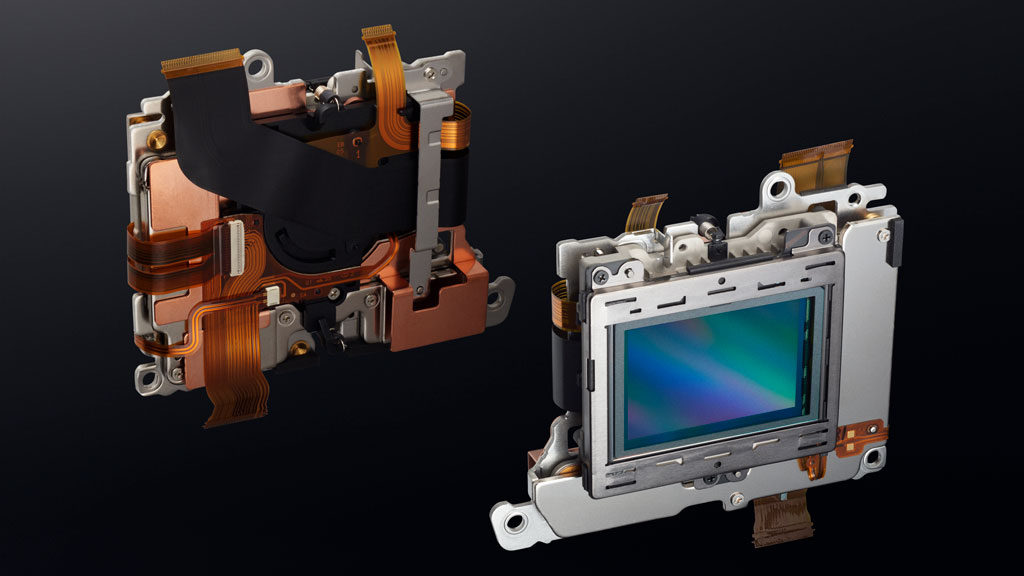
When a lens with optical stabilisation is mounted, both cameras can combine sensor and optical performance. With a lens that lack electronic contacts, 3 axes are used on each camera.
The stabilisation system works for video as well with the possibility of adding electronic stabilisation, an option not available on the Sony camera.
However the Sony takes advantage of this hardware for an extra feature called Pixel Shift Multi-Shoot: it takes four images in succession and moves the sensor by one pixel between each capture. Once composited in post production with a third party software (Sony Imaging Edge Suite), you get a file with more colour resolution than the single shot, although the image size doesn’t change (it’s still 42MP). It won’t give you good results hand-held or if moving elements are in the frame, but it can be an interesting mode for still life or landscapes.
![]()
7. Design and ease of use
The Z7 is not a big camera by any means; actually it is just a little larger than the A7R III. Yet thanks to the taller and bulkier grip, its handling was more comfortable than the A7R III, especially with large lenses. I also liked the larger buttons and their tactile feel. Overall the Z7 feels very well-built.
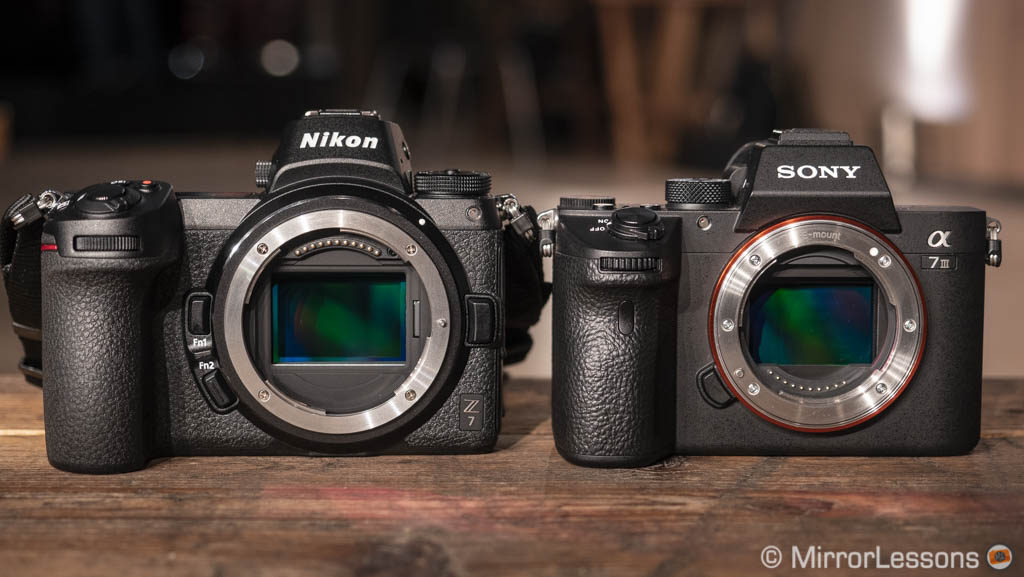
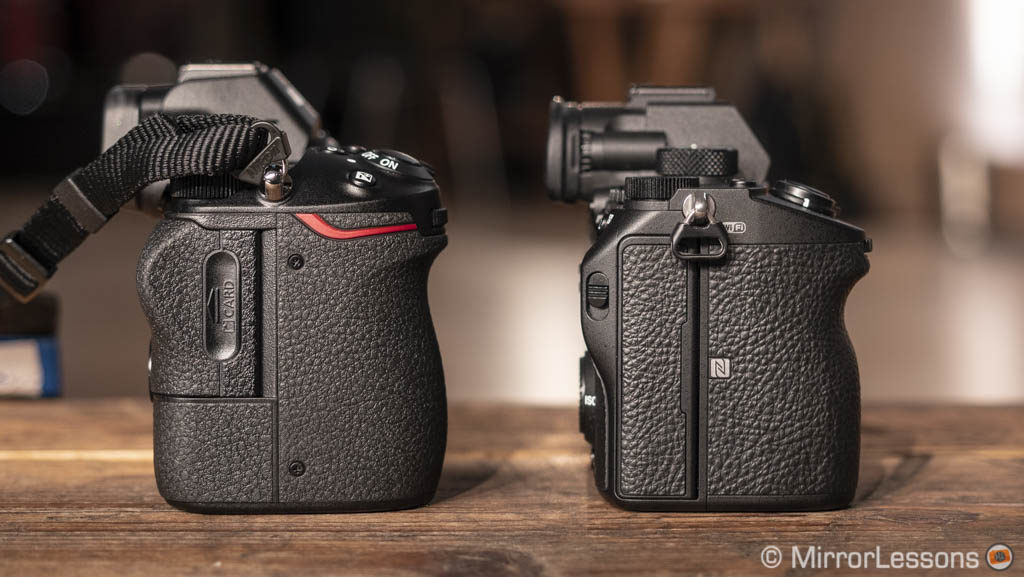
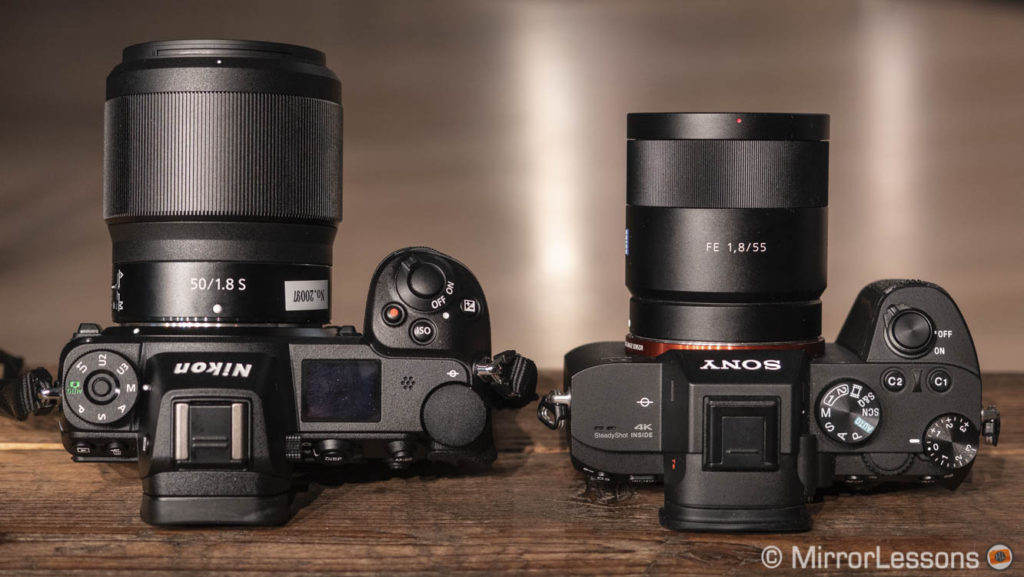
Both cameras are weather sealed and have a magnesium alloy chassis. There is a weight difference of not even 30g (675g for the Nikon, 657g for the Sony).
You’ll find a handy AF Joystick on both as well as many customisable buttons. On the Z7 I appreciated the lever to switch between stills and movie mode, the two front function buttons, as well as the possibility to edit the function of the control ring found on the new Z lenses. You can choose to use it to change the aperture, vary the focus point or the exposure compensation. Each camera has a personalised menu option and a quick menu.
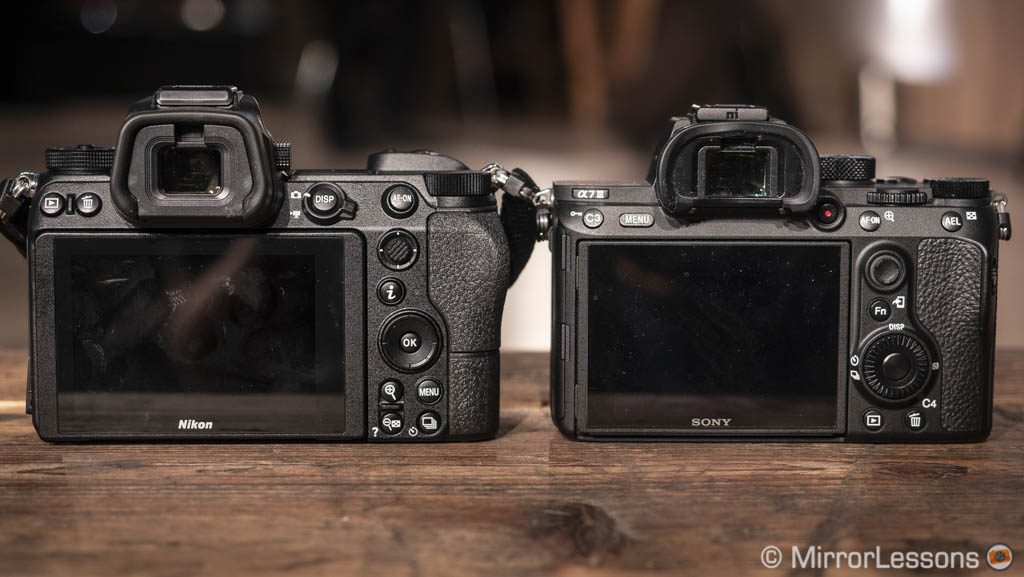
One thing that is disappointing a lot of users is the presence of just one memory card slot on the Z7. It uses the thicker XQD type card and I’m guessing there wasn’t enough space to put another next to it or underneath. It is a shame because we’ve been requesting dual card slots for many years and now that each mirrorless manufacturer has finally started to implement them, you would think Nikon would follow suit. The A7R III uses two SD slots, the first being UHS-II compliant.
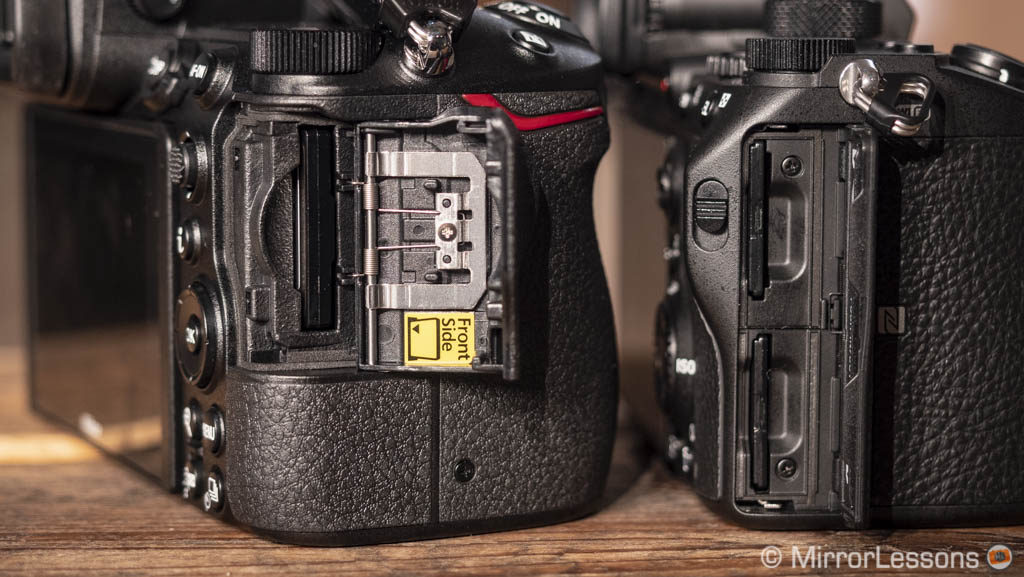 The A7 III on the other hand accepts two SD cards, the first slot being UHS-II compatible.
The A7 III on the other hand accepts two SD cards, the first slot being UHS-II compatible.
8. Screens and EVF
The Z7 has two screens: one small monochrome OLED on top to display various settings and a larger LCD on the rear.
The rear monitor on the Z7 is larger (3.2 vs 3 inches) and has more resolution (2,100k dots vs 922k dots). It offers touch sensitivity and there are different things you can do with it including moving the focus point, taking a shot or navigating the menu.
On the A7 III, the touch screen can only be used to move the AF area, although with an extra option you won’t find in the Z7: use it as an AF Pad while using the EVF.
Both feature an electronic viewfinder with 3.6M dots. The magnification is slightly higher on the Nikon (0.8x vs 0.78x) but the Sony has a longer eyepoint (23mm vs 21mm). The refresh rate of the Z7 is around 60fps, whereas the A7R III lets you choose between 50/60fps and 100/120fps.
9. Battery life
The Z7 is rated at 330 shots by CIPA standards, which is a little disappointing considering that it uses the same battery found inside the D850 whose rating is more than 1000 shots. Fortunately my tests showed that it can do better than that, but it doesn’t match the great performance of the Sony battery.
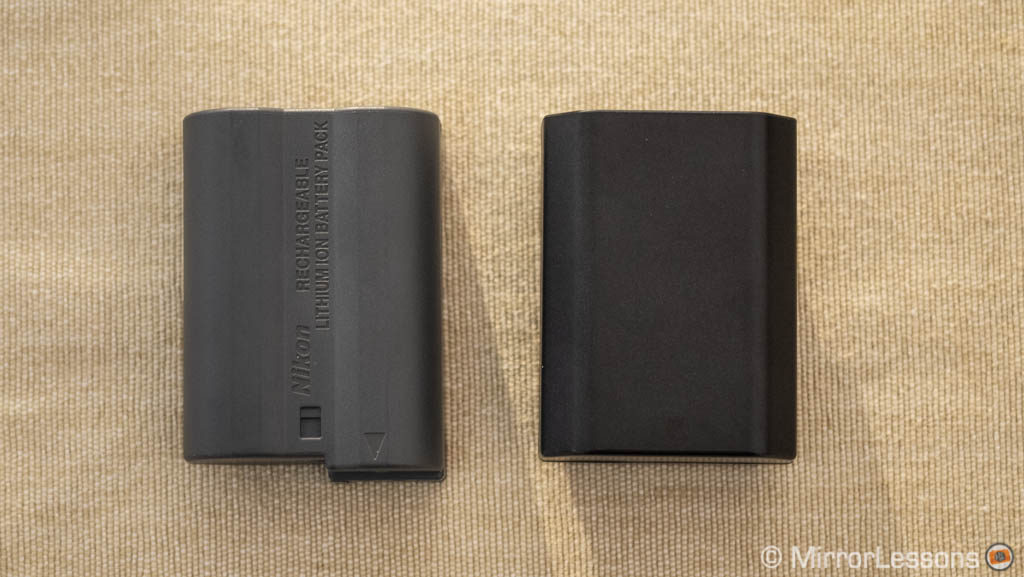
The A7R III has an official rating of around 530 shots but I managed way better than that. For instance, on one occasion I took home more than 2000 images and still had 35% power left to spare.
10. Lenses
Comparisons between different systems always involves talking about the lenses each brand has to offer. Here of course Sony has a clear advantage: the FE system has been around for more than four years and the company has worked hard to bring no fewer than 28 native lenses, and that excludes the offerings from third-party brands such as Sigma, Tamron, Samyang and Zeiss.
Nikon has just launched the Z series, so we can’t expect a lot yet. Still I like the three lenses they decided to release first. We get a 24-70mm f4 which is also the kit lens, and two primes: a 35mm f1.8 and 50mm f1.8. More lenses will come in 2019 and 2020 as you can see from the chart below.
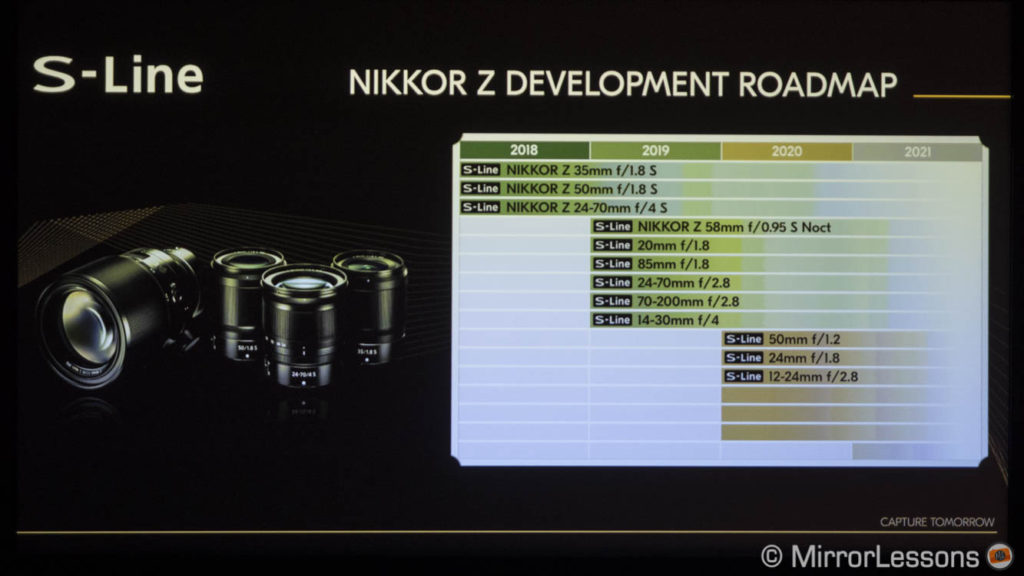
Looking at the roadmap we find a 58mm f0.95 and Nikon explained that one of the reasons they decided to design such a large mount is to be able to produce fast lenses like the new Noct. They also believe that the new mount will allow them to design a new generation of superior optics so I’ll be curious to see what kind of optical performance they’ll come up with.
If we include adapted lenses, the choice increases for both users. There are many adapters available for the Sony to use SLR manual focus and autofocus lenses. Nikon has designed its own adapter, the FTZ, to make 93 lenses fully compatible with the new camera.
Conclusion
Update: our Z7 vs A7R III full comparison is now online!
Like its sibling the Z6, the Z7 introduces many things we were expecting from Nikon including good ergonomics and similar specifications to its flagship DSLRs. I can’t help but think that the lack of two card slots and the limited battery life have somewhat diminished the excitement that preceded their announcement. But before we come to any solid conclusions, the Z7 certainly deserves thorough testing to see how good the new sensor is, how well the autofocus behaves and of course what kind of quality it will deliver on the video side.
The problem, if we want to call it that, is that technologically speaking the Z7 doesn’t bring anything substantial to the table that will help it stand out in comparison to the A7R III. The fact that it’s a little late to the mirrorless party doesn’t help its case either.
But if we forget for a second who came first, and the more geeky aspects of photography gear, I think the Z7 has a good chance of winning over many photographers. It can certainly appeal to those who haven’t yet considered switching to a mirrorless system, and want to try something that already feels familiar to their DSLR setup. It can also be of interest to those who are not convinced by the Sony design and consider this particular aspect more important than others.
For now, the Z7 is at a small disadvantage when it comes to price but that could even out later on. (Z7 is $3400 / £3400 / €3999, A7 III is $3200 / £3200 / €3500). Hopefully the Z system will further stimulate the competition on the mirrorless market and prove a worthy challenger for the E-mount series, and that is usually a good thing as it encourages the brand to improve. Plus we camera aficionados will benefit from it (as long as the bank account allows for it!).
Check price of the Nikon Z7 on
Check price of the Sony A7R III on
Amazon | Amazon UK | B&H Photo | eBay
Nikon Z comparison previews:

